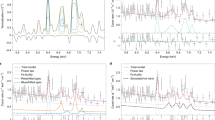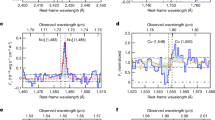Abstract
There is a supermassive black hole of mass 4 × 106 solar masses at the centre of the Milky Way1,2. A large reservoir of hot (107 kelvin) and cooler (102 to 104 kelvin) gas surrounds it within a few parsecs3. Although constraints on the amount of hot gas in the accretion zone of the black hole—that is, within 105 Schwarzschild radii (0.04 parsecs)—have been provided by X-ray observations4,5,6, the mass in cooler gas has been unconstrained. One possible way this cooler gas could be detected is by its emission in hydrogen recombination spectral lines7,8. Here we report imaging of a 104-kelvin ionized gas disk within 2 × 104 Schwarzschild radii, using the 1.3-millimetre recombination line H30α. This emission line is double-peaked, with full velocity linewidth of about 2,200 kilometres per second. The emission is centred on the radio source Sagittarius A*, but the redshifted side is displaced 0.11 arcsec (0.004 parsecs at a distance of 8 kiloparsecs) to the northeast and the blueshifted side is displaced a similar distance to the southwest. We interpret these observations in terms of a rotating disk of mass 10−5 to 10−4 solar masses and mean hydrogen density of about 105 to 106 per cubic centimetre, with the values being sensitive to the assumed geometry. The emission is stronger than expected, given the upper limit on the strength of the Brγ spectral line of hydrogen. We suggest that the H30α transition is enhanced by maser emission.
This is a preview of subscription content, access via your institution
Access options
Access Nature and 54 other Nature Portfolio journals
Get Nature+, our best-value online-access subscription
$29.99 / 30 days
cancel any time
Subscribe to this journal
Receive 51 print issues and online access
$199.00 per year
only $3.90 per issue
Buy this article
- Purchase on Springer Link
- Instant access to full article PDF
Prices may be subject to local taxes which are calculated during checkout


Similar content being viewed by others
Data availability
This paper makes use of the following ALMA data: ADS/JAO.ALMA #2015.1.00311.S. The data are publicly available from the ALMA archive at https://almascience.nrao.edu.
Code availability
We used the Common Astronomy Software Applications package (CASA) for the data reduction and analysis. We used Astropy, Python and Mathematica for plotting and data analysis. For the modelling of the spectra, we used the proprietary Code for AGN Reverberation and Modelling of Emission Lines (CARAMEL27). The key result presented in this paper is observational. The results of the CARAMEL modelling are not critical for interpretation of the observational data and therefore we are not releasing the code with this paper.
References
Boehle, A. et al. An improved distance and mass estimate for Sgr A* from a multistar orbit analysis. Astrophys. J. 830, 17 (2016).
Gravity Collaboration Detection of the gravitational redshift in the orbit of the star S2 near the Galactic centre massive black hole. Astron. Astrophys. 615, L15 (2018).
Genzel, R., Eisenhauer, F. & Gillessen, S. The Galactic Center massive black hole and nuclear star cluster. Rev. Mod. Phys. 82, 3121–3195 (2010).
Baganoff, F. K. et al. Chandra X-ray spectroscopic imaging of Sagittarius A* and the central parsec of the Galaxy. Astrophys. J. 591, 891–915 (2003).
Quataert, E. A thermal bremsstrahlung model for the quiescent X-ray emission from Sagittarius A*. Astrophys. J. 575, 855–859 (2002).
Quataert, E. A dynamical model for hot gas in the Galactic Center. Astrophys. J. 613, 322–325 (2004).
Scoville, N. & Murchikova, L. Submillimeter recombination lines in dust-obscured starbursts and active galactic nuclei. Astrophys. J. 779, 75 (2013).
Lynden-Bell, D. & Rees, M. J. On quasars, dust and the Galactic Centre. Mon. Not. R. Astron. Soc. 152, 461–475 (1971).
Remijan, A., Seifert, N. A. & McGuire, B. A. The database for astronomical spectroscopy—updates, additions and plans for Splatalogue for Alma full science operations. In 71st International Symposium on Molecular Spectroscopy FB11, http://hdl.handle.net/2142/91510 (2016).
Gravity Collaboration Detection of orbital motions near the last stable circular orbit of the massive black hole SgrA*. Astron. Astrophys. 618, L10 (2018).
Phinney, E. S. Ion pressure-supported accretion tori and the origin of radio jets—a plea for specific advice on the plasma physics. ESA Spec. Publ. 161, 337 (1981).
Rees, M. J., Begelman, M. C., Blandford, R. D. & Phinney, E. S. Ion-supported tori and the origin of radio jets. Nature 295, 17–21 (1982).
Narayan, R. & Yi, I. Advection-dominated accretion: underfed black holes and neutron stars. Astrophys. J. 452, 710 (1995).
Blandford, R. D. & Begelman, M. C. On the fate of gas accreting at a low rate onto a black hole. Mon. Not. R. Astron. Soc. 303, L1–L5 (1999).
Quataert, E. & Gruzinov, A. Convection-dominated accretion flows. Astrophys. J. 539, 809–814 (2000).
Ressler, S. M., Quataert, E. & Stone, J. M. Hydrodynamic simulations of the inner accretion flow of Sagittarius A* fueled by stellar winds. Mon. Not. R. Astron. Soc. 478, 3544–3563 (2018).
Goicoechea, J. R. et al. High-speed molecular cloudlets around the Galactic Center supermassive black hole. Astron. Astrophys. 618, A35 (2018).
Witzel, G. et al. The post-periapsis evolution of Galactic Center source G1: the second case of a resolved tidal interaction with a supermassive black hole. Astrophys. J. 847, 80 (2017).
Witzel, G. et al. Detection of Galactic Center source G2 at 3.8 μm during periapse passage. Astrophys. J. 796, L8 (2014).
Plewa, P. M. et al. The post-pericenter evolution of the Galactic Center source G2. Astrophys. J. 840, 50 (2017).
Storey, P. J. & Hummer, D. G. Recombination line intensities for hydrogenic ions (Storey+ 1995). In VizieR Online Data Catalog 6064, https://ui.adsabs.harvard.edu/abs/1995yCat.6064....0S (1995).
Witzel, G. et al. Variability timescale and spectral index of Sgr A* in the near infrared: approximate Bayesian computation analysis of the variability of the closest supermassive black hole. Astrophys. J. 863, 15 (2018).
Bower, G. C. et al. Interferometric detection of linear polarization from Sagittarius A* at 230 GHz. Astrophys. J. 588, 331–337 (2003).
Tchekhovskoy, A. & McKinney, J. C. Prograde and retrograde black holes: whose jet is more powerful? Mon. Not. R. Astron. Soc. 423, L55–L59 (2012).
Mahadevan, R. Reconciling the spectrum of Sagittarius A* with a two-temperature plasma model. Nature 394, 651–653 (1998).
Yuan, F. & Narayan, R. Hot accretion flows around black holes. Annu. Rev. Astron. Astrophys. 52, 529–588 (2014).
Pancoast, A., Brewer, B. J. & Treu, T. Modelling reverberation mapping data—I. Improved geometric and dynamical models and comparison with cross-correlation results. Mon. Not. R. Astron. Soc. 445, 3055–3072 (2014).
Pancoast, A. et al. Stability of the broad-line region geometry and dynamics in Arp 151 over seven years. Astrophys. J. 856, 108 (2018).
Gillessen, S. et al. Detection of a drag force in G2’s orbit: measuring the density of the accretion flow onto Sgr A* at 1000 Schwarzschild radii. Astrophys. J. 871, 126 (2019).
Schödel, R., Merritt, D. & Eckart, A. The nuclear star cluster of the Milky Way: proper motions and mass. Astron. Astrophys. 502, 91–111 (2009).
Acknowledgements
We are grateful to N. Scoville for co-writing the observing proposal and his contribution to discussions of analysis and interpretation of the data and to J. Koda and J. Ott for discussing the data analysis, looking at the data and commenting on the paper. We are grateful to A. Ciurlo, A. Ghez, M. Morris and S. Gillessen for calculating the limit on Brγ and sharing it with us and discussions, and to E. Quataert, S. Ressler and J. Lu for bringing the Brγ non-detection to our attention and discussions. We thank Y. Levin, J. Cuadra, P. Goldreich, D. Lin, J. Guillochon, S. Naoz, G. Witzel, M. Coleman, S. Philippov, S. Tremaine, A. Loeb, Z. Haiman and J. Carlstrom for discussions and comments, and the North American ALMA Science Center scientists at the National Radio Astronomy Observatory, in particular A. Remijan, C. Vlahakis, M. Lacy, S. Stierwalt, A. Moullet, E. Keller and B. Kirk for their help and advice with the observational setups and data reduction. We also thank Z. Scoville for proofreading the manuscript. E.M.M. acknowledges the Bezos Fund for providing her stipend at the Institute for Advanced Study, D. and B. Groce for encouragement and for supporting her as a Groce Fellow at Caltech; and the NRAO Student Observational Support programme for supporting two years of her graduate studies. A.P. is supported by NASA through Einstein Postdoctoral Fellowship grant number PF5-160141 awarded by the Chandra X-ray Center, which is operated by the Smithsonian Astrophysical Observatory for NASA under contract NAS8-03060. ALMA is a partnership of the ESO (representing its member states), the NSF (USA) and the NINS (Japan), together with the NRC (Canada) and the NSC and the ASIAA (Taiwan) and the KASI (Republic of Korea), in cooperation with the Republic of Chile. The Joint ALMA Observatory is operated by the ESO, the AUI/NRAO and the NAOJ. The National Radio Astronomy Observatory is a facility of the National Science Foundation operated under cooperative agreement by Associated Universities, Inc.
Reviewer information
Nature thanks Andreas Burkert and Reinhard Genzel for their contribution to the peer review of this work.
Author information
Authors and Affiliations
Contributions
E.M.M. was the principal investigator of the observing proposal, analysed the observational data, conducted theoretical calculations, produced the figures, and wrote most of the paper. E.S.P. conducted theoretical calculations and made major contributions to the interpretation of the observational results and to writing the paper. A.P. modelled the observed spectra, wrote the modelling section, and contributed to interpretation of the observational results. R.D.B. made a substantial contribution to the interpretation of the observational results. All co-authors commented on the manuscript.
Corresponding author
Ethics declarations
Competing interests
The authors declare no competing interests.
Additional information
Publisher’s note: Springer Nature remains neutral with regard to jurisdictional claims in published maps and institutional affiliations.
Supplementary information
Supplementary Information
This file contains Supplementary Methods and Supplementary Figs. 1–3.
Rights and permissions
About this article
Cite this article
Murchikova, E.M., Phinney, E.S., Pancoast, A. et al. A cool accretion disk around the Galactic Centre black hole. Nature 570, 83–86 (2019). https://doi.org/10.1038/s41586-019-1242-z
Received:
Accepted:
Published:
Issue Date:
DOI: https://doi.org/10.1038/s41586-019-1242-z
Comments
By submitting a comment you agree to abide by our Terms and Community Guidelines. If you find something abusive or that does not comply with our terms or guidelines please flag it as inappropriate.



